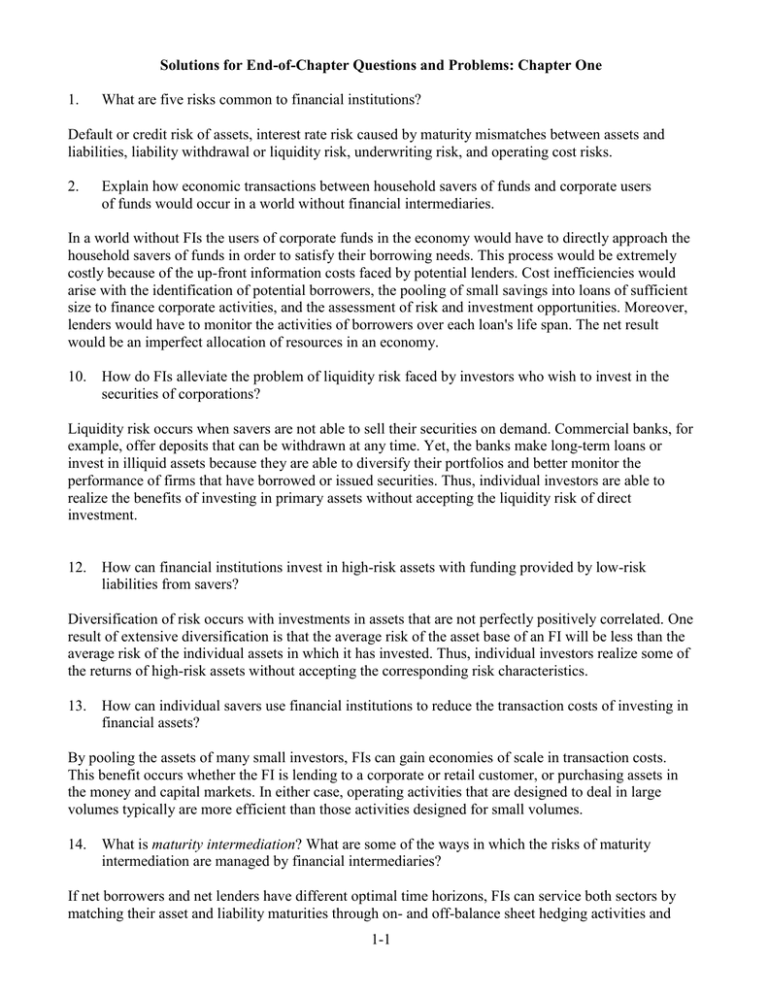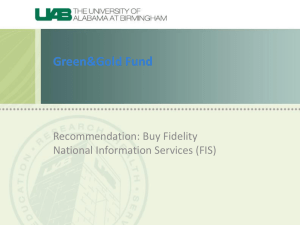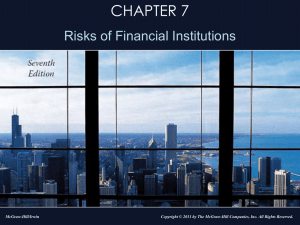1. What are five risks common to financial institutions?
advertisement

Solutions for End-of-Chapter Questions and Problems: Chapter One 1. What are five risks common to financial institutions? Default or credit risk of assets, interest rate risk caused by maturity mismatches between assets and liabilities, liability withdrawal or liquidity risk, underwriting risk, and operating cost risks. 2. Explain how economic transactions between household savers of funds and corporate users of funds would occur in a world without financial intermediaries. In a world without FIs the users of corporate funds in the economy would have to directly approach the household savers of funds in order to satisfy their borrowing needs. This process would be extremely costly because of the up-front information costs faced by potential lenders. Cost inefficiencies would arise with the identification of potential borrowers, the pooling of small savings into loans of sufficient size to finance corporate activities, and the assessment of risk and investment opportunities. Moreover, lenders would have to monitor the activities of borrowers over each loan's life span. The net result would be an imperfect allocation of resources in an economy. 10. How do FIs alleviate the problem of liquidity risk faced by investors who wish to invest in the securities of corporations? Liquidity risk occurs when savers are not able to sell their securities on demand. Commercial banks, for example, offer deposits that can be withdrawn at any time. Yet, the banks make long-term loans or invest in illiquid assets because they are able to diversify their portfolios and better monitor the performance of firms that have borrowed or issued securities. Thus, individual investors are able to realize the benefits of investing in primary assets without accepting the liquidity risk of direct investment. 12. How can financial institutions invest in high-risk assets with funding provided by low-risk liabilities from savers? Diversification of risk occurs with investments in assets that are not perfectly positively correlated. One result of extensive diversification is that the average risk of the asset base of an FI will be less than the average risk of the individual assets in which it has invested. Thus, individual investors realize some of the returns of high-risk assets without accepting the corresponding risk characteristics. 13. How can individual savers use financial institutions to reduce the transaction costs of investing in financial assets? By pooling the assets of many small investors, FIs can gain economies of scale in transaction costs. This benefit occurs whether the FI is lending to a corporate or retail customer, or purchasing assets in the money and capital markets. In either case, operating activities that are designed to deal in large volumes typically are more efficient than those activities designed for small volumes. 14. What is maturity intermediation? What are some of the ways in which the risks of maturity intermediation are managed by financial intermediaries? If net borrowers and net lenders have different optimal time horizons, FIs can service both sectors by matching their asset and liability maturities through on- and off-balance sheet hedging activities and 1-1 flexible access to the financial markets. For example, the FI can offer the relatively short-term liabilities desired by households and also satisfy the demand for long-term loans such as home mortgages. By investing in a portfolio of long-and short-term assets that have variable- and fixed-rate components, the FI can reduce maturity risk exposure by utilizing liabilities that have similar variable- and fixed-rate characteristics, or by using futures, options, swaps, and other derivative products. 17. What is meant by credit allocation regulation? What social benefit is this type of regulation intended to provide? Credit allocation regulation refers to the requirement faced by FIs to lend to certain sectors of the economy, which are considered to be socially important. These may include housing and farming. Presumably the provision of credit to make houses more affordable or farms more viable leads to a more stable and productive society. 19. What are two of the most important payment services provided by financial institutions? To what extent do these services efficiently provide benefits to the economy? The two most important payment services are check clearing and wire transfer services. Any breakdown in these systems would produce gridlock in the payment system with resulting harmful effects to the economy at both the domestic and potentially the international level. 21. What is negative externality? In what ways do the existence of negative externalities justify the extra regulatory attention received by financial institutions? A negative externality refers to the action by one party that has an adverse affect on some third party who is not part of the original transaction. For example, in an industrial setting, smoke from a factory that lowers surrounding property values may be viewed as a negative externality. For financial institutions, one concern is the contagion effect that can arise when the failure of one FI can cast doubt on the solvency of other institutions in that industry. 23. What is mortgage redlining? Mortgage redlining occurs when a lender specifically defines a geographic area in which it refuses to make any loans. The term arose because the area was often outlined on a map with a red pencil. 24. Why are FIs among the most regulated sectors in the world? When is net regulatory burden positive? FIs are required to enhance the efficient operation of the economy. Successful financial institutions provide sources of financing that fund economic growth opportunities that ultimately raise the overall level of economic activity. Moreover, successful financial institutions provide transaction services to the economy that facilitate trade and wealth accumulation. Conversely, distressed FIs create negative externalities for the entire economy. That is, the adverse impact of an FI failure is greater than just the loss to shareholders and other private claimants on the FI's assets. For example, the local market suffers if an FI fails and other FIs also may be thrown into financial distress by a contagion effect. Therefore, since some of the costs of the failure of an FI are 1-2 generally borne by society at large, the government intervenes in the management of these institutions to protect society's interests. This intervention takes the form of regulation. However, the need for regulation to minimize social costs may impose private costs to the FIs that would not exist without regulation. This additional private cost is defined as a net regulatory burden. Examples include the cost of holding excess capital and/or excess reserves and the extra costs of providing information. Although they may be socially beneficial, these costs add to private operating costs. To the extent that these additional costs help to avoid negative externalities and to ensure the smooth and efficient operation of the economy, the net regulatory burden is positive. 25. What forms of protection and regulation do regulators of FIs impose to ensure their safety and soundness? Regulators have issued several guidelines to insure the safety and soundness of FIs: a. b. c. d. 30. FIs are required to diversify their assets. For example, banks cannot lend more than 6 percent of their equity to a single borrower. FIs are required to maintain minimum amounts of capital to cushion any unexpected losses. In the case of banks, the Basle standards require a minimum core and supplementary capital based on the size of an FIs’ risk-adjusted assets. Regulators have set up guaranty funds such as BIF for commercial banks, SIPC for securities firms, and state guaranty funds for insurance firms to protect individual investors. Regulators also engage in periodic monitoring and surveillance, such as on-site examinations, and request periodic information from the FIs. How do regulations regarding barriers to entry and the scope of permitted activities affect the charter value of financial institutions? The profitability of existing firms will be increased as the direct and indirect costs of establishing competition increase. Direct costs include the actual physical and financial costs of establishing a business. In the case of FIs, the financial costs include raising the necessary minimum capital to receive a charter. Indirect costs include permission from regulatory authorities to receive a charter. Again in the case of FIs this cost involves acceptable leadership to regulators. As these barriers to entry are stronger, the charter value for existing firms is higher. 33. What characteristics of financial products are necessary for financial markets to become efficient alternatives to financial intermediaries? Give some examples of the commoditization of products which were previously the sole property of financial institutions? Financial markets can replace FIs in the delivery of products that (1) have standardized terms, (2) serve a large number of customers, and (3) are sufficiently understood for investors to be comfortable in assessing their prices. When these three characteristics are met, the products often can be treated as commodities. One example of this process is the migration of over-the-counter options to the publicly traded option markets as trading volume grows and trading terms become standardized. 1-3







